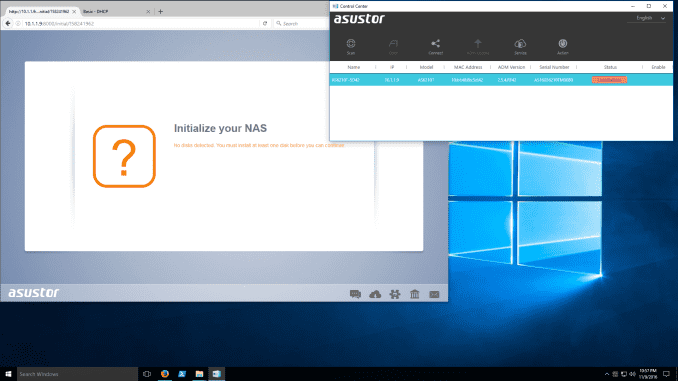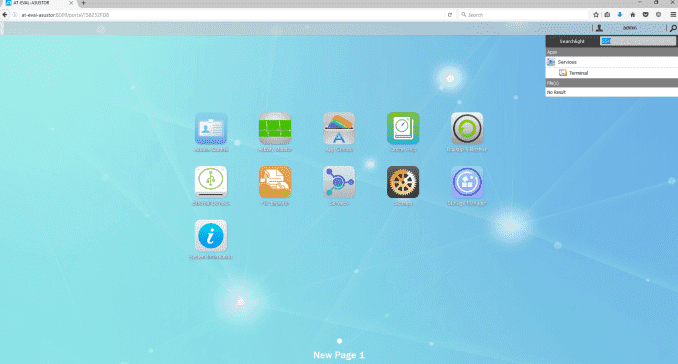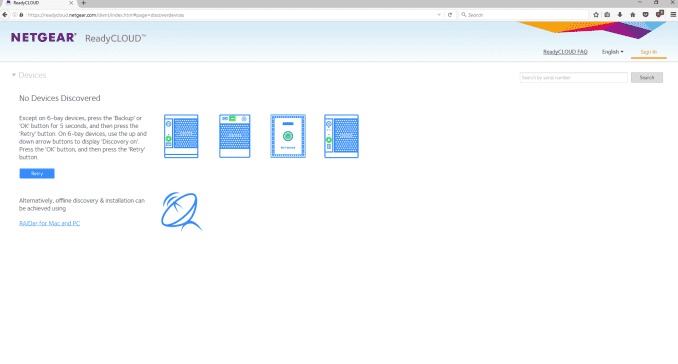The market for network-attached storage units has expanded significantly over the last few years. The rapid growth in public cloud storage (Dropbox, OneDrive, Google Drive and the like) has tempered the expansion a bit amongst consumers who are not very tech-savvy. However, the benefits provided by a NAS in the local network are undeniable, particularly when complemented with public cloud services. Enterprise users obviously need NAS units with different performance and feature requirements. Our previous NAS reviews have focused more on the performance aspect. With feature set and ease of use becoming important across all market segments, we believe that a qualitative evaluation of the different commercial NAS operating systems is needed to educate consumers on the options available.
Commercial off-the-shelf (COTS) NAS operating systems are popular across a wide range of market segments – business and enterprise users (including those with dedicated IT staff) prefer to have plug-and-play storage units that don’t need much babysitting, while the average consumer often wants a media-centric unit without the hassle of re-purposing an old PC or building a file server from scratch. This regularly-updated piece will take a look at the features and usability of the currently popular COTS NAS operating systems.
The following NAS vendors / operating systems are currently covered in this article:
- Asustor [ ADM 2.6.5R9N1 ]
- Netgear [ ReadyNAS OS 6.6.0 ]
- QNAP [ QTS 4.2.2 ]
- Synology [ DSM 6.0.2-8451 Update 3 ]
- Western Digital [ My Cloud OS 2.21.19 ]
- ZyXEL [ FW v5.20(AATB.0) ]
Different vendors cater to different market segments – both in terms of hardware and software features. For example, Asustor, Netgear, QNAP and Synology have units ranging from 2-bay desktop models targeting the average home consumer to 12-bay rackmounts targeting SMBs and SMEs. Western Digital has only desktop units- 1- and 2-bay models targeting entry level users, and multiple 2- and 4-bay models targeting experts, professionals and business users. ZyXEL, on the other hand, focuses on only one market segment – the average home consumer. Every vendor other than ZyXEL in the list above carries both ARM- and x86-based solutions. ZyXEL has only ARM-based solutions in their lineup. The choice between ARM and x86 has to be made by the end-user depending on the requirements (number of users, transcoding support etc.). This piece is not meant to provide inputs on the hardware choice, though we will briefly touch upon how the OS features might vary based on the platform. The hardware currently used to test out the various OS features are tabulated at the end of this section.
Security has turned out to be a very important concern for equipment connected to the network, particularly those exposed to the Internet. Therefore, frequent updates are needed even in the NAS firmwares to handle vulnerabilities that get exposed from time to time. The release date of the latest firmware is also a measure of the commitment of the NAS vendor to their consumers.
Most COTS NAS operating systems are based on Linux, and utilize software RAID (mdadm) with the stable ext4 file system. Recently, btrfs has also become popular in this space. ZFS, due to its resource-hungry nature, has been restricted to units targeting enterprise users. DIY consumers can also get a taste of it using open-source BSD-based operating systems such as FreeNAS.
The following table provides the essential information discussed above in a easy to compare manner.
| NAS Operating Systems Evaluation – Comparison Details | ||
| Vendor | ||
| Firmware Version | ADM 2.6.5R9N1 | ReadyNAS OS 6.6.0 |
| Firmware Release Date | October 3, 2016 | September 29, 2016 |
| OS Kernel | Linux 4.1.0 | Linux 4.1.30 |
| File System | ext4 | btrfs (Customized) |
| Evaluated Hardware | 10-bay AS6210T | 4-bay ReadyNAS RN214 |
This piece focuses on the core user-facing aspects of COTS NAS systems. These include the setup process and the quality of the user interface. Storage management and configurable services are the next topic. An overview of user management is followed by discussion of the networking features available in each OS.
Most NAS operating systems have feature parity in terms of core features. However, as we shall see at the end of this piece, there is a difference in ease of use which make some vendors stand out of the crowd. These vendors also try to differentiate with value-added services such as media servers, surveillance (IP camera) support, cloud features and other such features. They will be covered in detail in a follow-on article.
The setup process adopted by different NAS vendors is similar in many ways. Connecting a diskless NAS unit to the network results in the unit getting a DHCP address, with a web server up and running. A web browser can then be used to follow the step-by-step instructions to insert hard drives, configure an appropriate storage volume, set up access credentials and some other essential aspects of the NAS.
In order to make the process simpler for the average consumer, some vendors supply a separate program to search for their NAS units in the local network. These programs occasionally come with value-added features. The setup process for each vendor is discussed in detail in this section. Vendors are covered in alphabetical order. Readers interested in jumping ahead to a particular vendor can use the list below.
- Asustor
- Netgear
- QNAP
- Synology
- Western Digital
- ZyXEL
Asustor
Asustor supplies the Asustor Control Center program that can recognize the Asustor units in the local network with its ‘Scan’ function. It helpfully provides the DHCP IP of the NAS unit also, and the user can open a web browser for further setup.

After inserting empty hard drives into the unit, the NAS can be initialized. The flow also checks whether a newer firmware version (compared to the one currently in the DOM inside the unit) is available. Users can opt to continue initialization without updating the firmware, or allow it to be updated directly off the net, or allow the upload of the newer firmware from a local source. The setup wizard allows 1-click configuration, but, advanced users will usually end up opting for the customized manual configuration.
The initialization process requires setting up a password for the admin account, date and time settings (computer time, manual, or synchronizing with a NTP server), network configuration (link aggregation configuration, IP settings – DHCP or static), and volume settings (RAID level configuration with selected disks in the unit). The final step in the process is the optional registration.
After the initialization of the NAS, the Asustor Control Center (ACC) becomes much more useful. The ‘Open’ button opens the browser interface for the NAS, and the ‘Connect’ option can be used to map network drives, create a remote file folder (WebDAV or FTP), or open a connection to the NAS via FTP. The ‘Photo Gallery’ and ‘Surveillance Center’ services can also be accessed via ACC. WOL settings can be configured, and power control options are also provided.
On the whole, the setup process is fairly simple and the Asustor Control Center provides easy access to tasks that might be essential for certain users.
Asustor adopts an app-style browser UI for the NAS interface. Various options are arranged as a rectangular array of icons similar to what one sees in modern mobile operating systems.

One of the important aspects highlighted above is the ‘searchlight’ on the top of the page to the right. Often, it is difficult to remember where a particular option is buried in the layout. The searchlight helps take the user directly to the relevant section. Beyond the initial app view, the various windows that pop up within after selecting the available options follow a desktop-style UI.
Netgear
Netgear has completely revamped their OS a couple of times in the last 5 years. Starting from square one has resulted in their OS not being as feature-rich as the ones from other vendors in the market. For example, their local NAS discovery tool – RAIDar – is quite dated and requires Java to be installed. None of the other vendors we are covering in this article require Java for that tool.

Fortunately, Netgear also has a cloud discovery mode using the ‘ReadyCloud’ feature. We tried it out with mixed luck, as shown the gallery below.
Eventually, we moved to the offline installation mode that involved accessing the DHCP IP (getting to that point still involved accessing the unit physically after inserting the disks – something that wasn’t needed for units from other vendors). The usual time and date settings, host name, and login credentials could be configured. One of the interesting aspects was the ability to configure alerts to be sent to an e-mail ID during the setup process itself (other vendors have it as a buried option in their OS). The other was the automatic configuration of the disks in X-RAID (unlike other vendors who allow the RAID level to be chosen by the user during the setup process). End users can always remove the volume and reconfigure it after the initialization is complete.
In our evaluation, Netgear’s setup process based on ReadyCLOUD doesn’t appear to be very robust, while the offline installation mode requires more babysitting that we would like. Netgear also needs to create a version of RAIDar that can work without Java. All said, power users will not have any trouble getting a ReadyNAS unit up and running.
The ReadyNAS OS 6 browser UI is spartan compared to what we see from other vendors. It follows a ribbon-style set of menus – the first row…
























